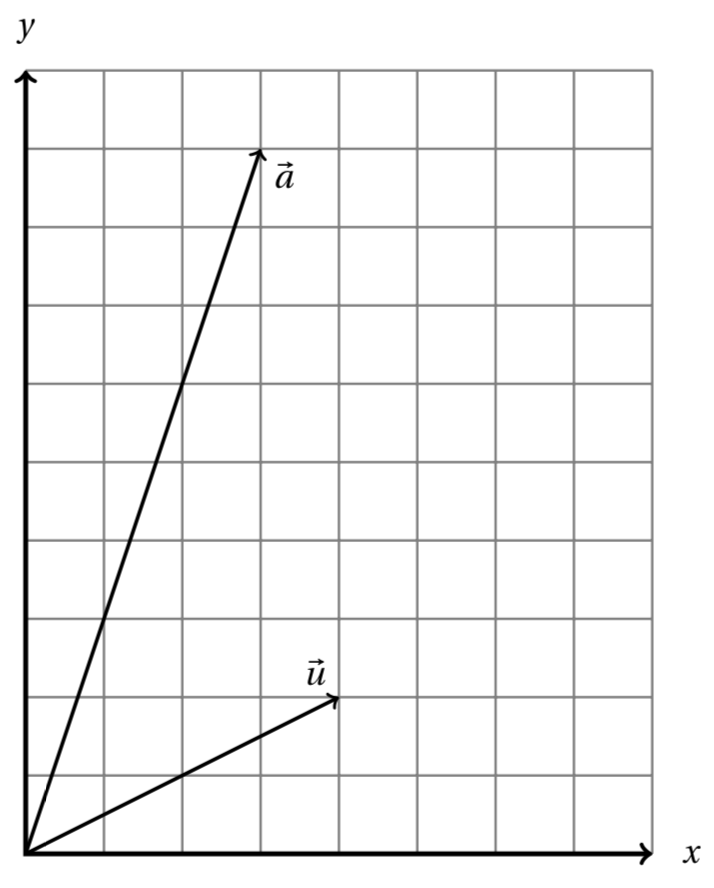<worksheet label="worksheet-dot-products" courseid="MAT-150" series="Activity" seriescode="13">
<title>Dot products and projection</title>
<page>
<sidebyside width="45%" margins="0%">
<exercise>
<introduction>
<p>
Let <m>{\vec v}_1 = (-4,1)</m>,
<m>{\vec v}_2 = (2,2)</m>,
<m>{\vec v}_3 = (1,2,3)</m>, <m>{\vec v}_4 = (-2,1,0)</m>.
Find the values of the following expressions:
</p>
</introduction>
<task workspace="1in">
<p>
<m>{\vec v}_1 \cdot {\vec v}_2 = <fillin/></m>
</p>
</task>
<task workspace="1.0in">
<p>
<m>{\vec v}_3 \cdot {\vec v}_4 = <fillin/></m>
</p>
</task>
<task workspace="1in">
<p>
<m>\lVert{\vec v}_1\rVert = <fillin/></m>
</p>
</task>
<task workspace="1in">
<p>
<m>\lVert{\vec v}_4\rVert = <fillin/></m>
</p>
</task>
<task workspace="1in">
<p>
Are any of these vectors perpendicular to each other?
<fillin/>
</p>
</task>
</exercise>
<exercise workspace="3in">
<statement>
<p>
The vectors <m>\vec a = (3,9)</m> and <m>\vec u = (4,2)</m> are pictured below.
Derive the formula for projection on a line and use it to find the projection of <m>\vec a</m> on the line spanned by <m>\vec u</m>.
Also compute the length of the residual vector.
</p>
<image width="100%" source="images/projection1.png">
<shortdescription>two vectors in a Cartesian plane</shortdescription>
</image>
</statement>
</exercise>
</sidebyside>
</page>
<page>
<sidebyside width="48%" margins="0%">
<exercise workspace="1.25in">
<introduction>
<p>
Consider the vector equation
<me>
m \begin{bmatrix}2 \\ 5\end{bmatrix} = \begin{bmatrix}3 \\ 7\end{bmatrix}
</me>.
</p>
</introduction>
<task>
<p>
Check that there is no solution <m>m</m> that makes the equation true.
</p>
</task>
<task>
<p>
Use projection to find the best approximation <m>\hat m</m>.
</p>
</task>
<task>
<p>
Compute <m>\hat m \begin{bmatrix}2 \\ 5\end{bmatrix} </m>.
</p>
</task>
<task>
<p>
Compute the residual vector.
</p>
</task>
<task>
<p>
Compute the length of the residual vector and explain what it means.
</p>
</task>
</exercise>
<exercise>
<introduction>
<p>
Consider the system of equations
<md>
<mrow>3t \amp =5</mrow>
<mrow>2t \amp = 9</mrow>
</md>.
</p>
</introduction>
<task workspace="2in">
<p>
Write the system in vector form.
</p>
</task>
<task workspace="3.9in">
<p>
Find the best estimate, <m>\hat t</m>,
of <m>t</m> using projection.
</p>
</task>
<task workspace="2in">
<p>
Compute the length of the residual vector.
</p>
</task>
</exercise>
</sidebyside>
</page>
</worksheet>
Worksheet 35.4 Dot products and projection
View Source for worksheet
1.
View Source for exercise
<exercise>
<introduction>
<p>
Let <m>{\vec v}_1 = (-4,1)</m>,
<m>{\vec v}_2 = (2,2)</m>,
<m>{\vec v}_3 = (1,2,3)</m>, <m>{\vec v}_4 = (-2,1,0)</m>.
Find the values of the following expressions:
</p>
</introduction>
<task workspace="1in">
<p>
<m>{\vec v}_1 \cdot {\vec v}_2 = <fillin/></m>
</p>
</task>
<task workspace="1.0in">
<p>
<m>{\vec v}_3 \cdot {\vec v}_4 = <fillin/></m>
</p>
</task>
<task workspace="1in">
<p>
<m>\lVert{\vec v}_1\rVert = <fillin/></m>
</p>
</task>
<task workspace="1in">
<p>
<m>\lVert{\vec v}_4\rVert = <fillin/></m>
</p>
</task>
<task workspace="1in">
<p>
Are any of these vectors perpendicular to each other?
<fillin/>
</p>
</task>
</exercise>
Let \({\vec v}_1 = (-4,1)\text{,}\) \({\vec v}_2 = (2,2)\text{,}\) \({\vec v}_3 = (1,2,3)\text{,}\) \({\vec v}_4 = (-2,1,0)\text{.}\) Find the values of the following expressions:
(a)
View Source for task
<task workspace="1in">
<p>
<m>{\vec v}_1 \cdot {\vec v}_2 = <fillin/></m>
</p>
</task>
\({\vec v}_1 \cdot {\vec v}_2 = \fillinmath{XXX}\)
(b)
View Source for task
<task workspace="1.0in">
<p>
<m>{\vec v}_3 \cdot {\vec v}_4 = <fillin/></m>
</p>
</task>
\({\vec v}_3 \cdot {\vec v}_4 = \fillinmath{XXX}\)
(c)
View Source for task
<task workspace="1in">
<p>
<m>\lVert{\vec v}_1\rVert = <fillin/></m>
</p>
</task>
\(\lVert{\vec v}_1\rVert = \fillinmath{XXX}\)
(d)
View Source for task
<task workspace="1in">
<p>
<m>\lVert{\vec v}_4\rVert = <fillin/></m>
</p>
</task>
\(\lVert{\vec v}_4\rVert = \fillinmath{XXX}\)
(e)
View Source for task
<task workspace="1in">
<p>
Are any of these vectors perpendicular to each other?
<fillin/>
</p>
</task>
Are any of these vectors perpendicular to each other?
2.
View Source for exercise
<exercise workspace="3in">
<statement>
<p>
The vectors <m>\vec a = (3,9)</m> and <m>\vec u = (4,2)</m> are pictured below.
Derive the formula for projection on a line and use it to find the projection of <m>\vec a</m> on the line spanned by <m>\vec u</m>.
Also compute the length of the residual vector.
</p>
<image width="100%" source="images/projection1.png">
<shortdescription>two vectors in a Cartesian plane</shortdescription>
</image>
</statement>
</exercise>
The vectors \(\vec a = (3,9)\) and \(\vec u = (4,2)\) are pictured below. Derive the formula for projection on a line and use it to find the projection of \(\vec a\) on the line spanned by \(\vec u\text{.}\) Also compute the length of the residual vector.

3.
View Source for exercise
<exercise workspace="1.25in">
<introduction>
<p>
Consider the vector equation
<me>
m \begin{bmatrix}2 \\ 5\end{bmatrix} = \begin{bmatrix}3 \\ 7\end{bmatrix}
</me>.
</p>
</introduction>
<task>
<p>
Check that there is no solution <m>m</m> that makes the equation true.
</p>
</task>
<task>
<p>
Use projection to find the best approximation <m>\hat m</m>.
</p>
</task>
<task>
<p>
Compute <m>\hat m \begin{bmatrix}2 \\ 5\end{bmatrix} </m>.
</p>
</task>
<task>
<p>
Compute the residual vector.
</p>
</task>
<task>
<p>
Compute the length of the residual vector and explain what it means.
</p>
</task>
</exercise>
Consider the vector equation
\begin{equation*}
m \begin{bmatrix}2 \\ 5\end{bmatrix} = \begin{bmatrix}3 \\ 7\end{bmatrix}\text{.}
\end{equation*}
(a)
View Source for task
<task>
<p>
Check that there is no solution <m>m</m> that makes the equation true.
</p>
</task>
Check that there is no solution \(m\) that makes the equation true.
(b)
View Source for task
<task>
<p>
Use projection to find the best approximation <m>\hat m</m>.
</p>
</task>
Use projection to find the best approximation \(\hat m\text{.}\)
(c)
View Source for task
<task>
<p>
Compute <m>\hat m \begin{bmatrix}2 \\ 5\end{bmatrix} </m>.
</p>
</task>
Compute \(\hat m \begin{bmatrix}2 \\ 5\end{bmatrix} \text{.}\)
(d)
View Source for task
<task>
<p>
Compute the residual vector.
</p>
</task>
Compute the residual vector.
(e)
View Source for task
<task>
<p>
Compute the length of the residual vector and explain what it means.
</p>
</task>
Compute the length of the residual vector and explain what it means.
4.
View Source for exercise
<exercise>
<introduction>
<p>
Consider the system of equations
<md>
<mrow>3t \amp =5</mrow>
<mrow>2t \amp = 9</mrow>
</md>.
</p>
</introduction>
<task workspace="2in">
<p>
Write the system in vector form.
</p>
</task>
<task workspace="3.9in">
<p>
Find the best estimate, <m>\hat t</m>,
of <m>t</m> using projection.
</p>
</task>
<task workspace="2in">
<p>
Compute the length of the residual vector.
</p>
</task>
</exercise>
(a)
View Source for task
<task workspace="2in">
<p>
Write the system in vector form.
</p>
</task>
Write the system in vector form.
(b)
View Source for task
<task workspace="3.9in">
<p>
Find the best estimate, <m>\hat t</m>,
of <m>t</m> using projection.
</p>
</task>
(c)
View Source for task
<task workspace="2in">
<p>
Compute the length of the residual vector.
</p>
</task>
Compute the length of the residual vector.

